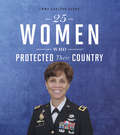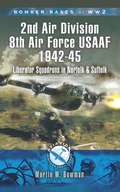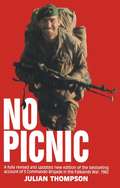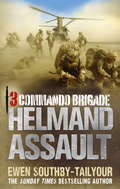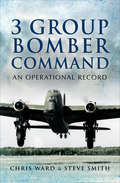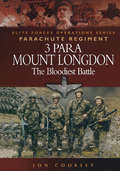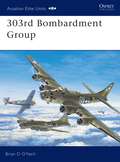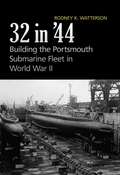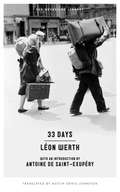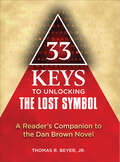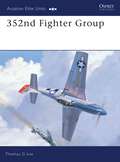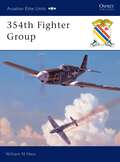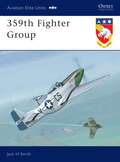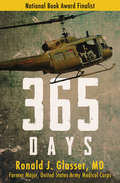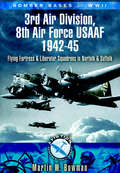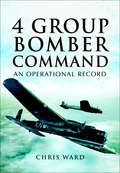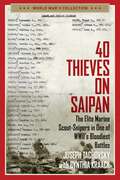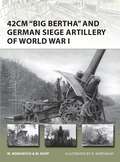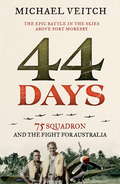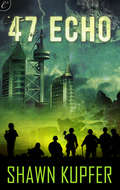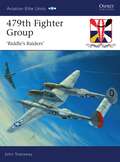- Table View
- List View
25 Women Who Protected Their Country (Daring Women)
by Emma Carlson Berne Emma BernayDiscover 25 women who served in the military and accomplished great feats of strength and bravery. Whether through medicine, espionage, journalism, or combat, these 25 women show what it takes to be a hero.
27 Articles
by T. E. Lawrence John Hulsman David Rhodes27 Articles is Lawrence of Arabia’s classic set of guidelines on military leadership in the Middle East. The 100th anniversary edition features a new introduction by foreign policy expert John Hulsman and a new afterword from CBS News President David Rhodes, addressing the articles’ lasting lessons.In 1916, T.E. Lawrence was deployed to the Arabian Peninsula to aid with the Arab Revolt against the Ottoman Empire. It was the middle of World War I and the British command was throwing its weight behind the long-rebellious southern territories of the Ottoman Empire. Lawrence had extraordinary success fighting alongside the coalition of Arab revolutionaries, and his story has since become legend. Worried that Lawrence would die on the battlefield and that his knowledge would vanish with him, British command asked Lawrence to write out a series of guidelines on his own tactics and teachings. 27 Articles, the text of Lawrence’s guidelines, has become required reading for military leaders. Lawrence’s deployment was the West’s first modern involvement in war in the Middle East, and his campaign held myriad lessons for future generations. Despite being a century old, the articles are deeply prescient on the challenges America has faced in its wars in Iraq and Afghanistan. Terse and to the point, Lawrence’s articles begin on the battlefield but their value extends well beyond, into the fields of management, leadership, and business. On the 100th anniversary of 27 Articles’ original publication, foreign policy John Hulsman and CBS News President David Rhodes now speak to the articles’ ongoing importance, outlining the wisdom they hold for political, military, and business leaders on into the future.
2nd Air Division Air Force USAAF 1942-45: Liberator Squadrons in Norfolk and Suffolk (Bomber Bases of WW2)
by Martin W. BowmanA history and guide to historic British airfields where American bombers were prepared to take off at a moment’s notice—includes photos.As part of the AHT series, the airfields and interest in this book are concentrated in a particular area—in this case Norfolk and Suffolk.The Second Air Division’s first bombing mission was flown on November 7, 1942; the last on April 25, 1945. A total of 95, 948 sorties were flown in 493 operational missions by the division’s B-24s, dropping 199,883 tons of bombs. Targets attacked ranged from Norway in the north, as far east as Poland and Romania, while several Mediterranean countries were reached from temporary bases in North Africa. Six 2nd Air Division groups received special presidential citations for outstanding actions and five airmen received the Medal of Honor (highest US award for bravery), four posthumously. In combat the 2nd Air Division gunners claimed 1,079 enemy fighters destroyed against losses of 1,458 B-24s missing in action and many others lost in accidents. This book looks at the history and personalities associated with each base, what remains today and explores the favourite local wartime haunts where aircrew and ground crew would go.
3 Commando Brigade in the Falklands: No Picnic (Cassell Military Paperbacks Ser.)
by Julian ThompsonMajor General Julian Thompson first wrote No Picnic when the momentous events of April - June 1982 were fresh in his mind. As Commander of 3 Commando Brigade, he was at the heart of the planning and conduct of the War. Under his direct command had been the Royal Marine Commandos and the two battalions of the Parachute Regiment who conducted the lion's share of the fighting.No-one therefore is better qualified to tell the extraordinary story of there-taking of the Falkland Islands from the Argentinians. The author, now a celebrated military historian, has revised his early book and added for this 25 Anniversary edition more of his own personal thoughts and impressions.It is all too easy to overlook just how perilous and risky a venture this expedition to the depths of the Southern Hemisphere was. Victory and defeat hung in the balance. Even those who feel they know about this most remarkable of wars will learn more from reading this classic account.
3 Commando: Helmand Assault
by Ewen Southby-TailyourWhen the Royal Marines Commandos returned to a chaotic Helmand in the winter of 2008, they realised that to stand any chance of success they would need to pursue an increasingly determined Taliban harder than ever before. This time they were going to hunt them down from the air. With the support of Chinooks, Apaches, Lynx, Sea Kings and Harriers, the Commandos became a deadly mobile unit, able to swoop at a moments notice into the most hostile territory.From huge operations like the gruelling Red Dagger, when 3 Commando Brigade fought in Somme-like mud to successfully clear the area around the capital of Helmand, Lashkar Gar, of encroaching enemy forces, to the daily acts of unsupported, close-quarters 360-degree combat and the breath-taking, rapid helicopter night assaults behind enemy lines - this was kind of battle that brought Commando qualities to the fore. As with the Sunday Times bestselling 3 Commando Brigade, ex-Marine Lieutenant Colonel Ewen Southby-Tailyour brings unparalleled access to the troops, a soldier's understanding of the conflict and a visceral sense of the combat experience. This is the real war in Afghanistan as told to him by a hand-picked band of young fellow marines as they encounter the daily rigours of life on the ground in the world's most intense war zone.
3 Group Bomber Command: An Operational Record
by Steve Smith Chris WardDuring the immediate period before World War Two, the RAF modified its command structure to rationalize for rapid expansion. Bomber Command was divided into six operational groups, each flying the same type of aircraft.3 Group had almost completely re-equipped with the Wellington by 4 September 1939 to carry out the second bombing operation of the war which was against German warships off Brunsbttel. In 1940 the first of the new four-engined bombers, the Short Stirling, came into service with the Group, being followed in 1942 by the Avro Lancaster. On 3rd/4th November 1943, No. 3 Group played a leading part in the first bombing attack in which heavy bombers made use of the radar bombing aid known as G-H. The target was Dsseldorf; bombs were dropped "blind" and good results were obtained. In July and August 1944, aircraft of this Group equipped with G-H maintained an all-weather attack against flying-bomb sites. Through the D-Day build-up, the liberation of France and conquest of Germany, formations of No. 3 Group attacked railway junctions, marshalling yards, troop concentrations, etc.During the week ending 25th March 1945, Bomber Command made numerous attacks to prepare for the crossing of the Rhine.
3 Para Mount Longdon: The Bloodiest Battle (Elite Forces Operations Series)
by Jon CookseyThe author of Falklands Hero follows the Third Parachute Battalion through a ferocious battle to secure a key strategic position during the Falklands War. This, the first in a series on Special Operations, tells the story of Three Para and the often-neglected struggle for Mount Longdon. It was a battle that tested the discipline, comradeship, and professionalism of the Paras to the limit; it was a battle that witnessed another posthumous Victoria Cross; it turned out to be the bloodiest battle of the entire Falklands Campaign. &“Like many a fascist state before them the Argentine Junta thought they could steal territory that belonged to someone else who they considered weak. It came as a shock when Britain rapidly assembled a Task Force and sent it 8,000 miles to eject the Argentine bandits. . . . It was a victory of British military skill and courage in spite of the neglect by politicians. . . . The author has told the story with skill and insight.&” —Firetrench.com
30 Years After: Issues and Representations of the Falklands War
by Carine Berbéri Monia O’Brien CastroThirty years after the Argentinian invasion of the Falkland Islands, the war remains a source of continued debate and analysis for politicians, historians and military strategists. Not only did the conflict provide a fascinating example of modern expeditionary warfare, but it also brought to the fore numerous questions regarding international law, sovereignty, the inheritance of colonialism, the influence of history on national policy and the use of military force for domestic political uses. As the essays in this collection show, the numerous facets of the Falklands War remain current today and have ramifications far beyond the South Atlantic. Covering issues ranging from military strategy to Anglo-American relations, international reactions and international law to media coverage, the volume provides an important overview of some of the complex issues involved, and offers a better understanding of this conflict and of the tensions which still exist today between London and Buenos Aires. Of interest to scholars of history, politics, international relations and defence studies, the volume provides a timely and forthright examination of a short but bloody episode of a kind that is likely to be seen with increasing frequency, as nations lay competing claims to disputed territories around the globe.
303rd Bombardment Group
by Mark Styling Brian O'NeillThe first title in the Elite Units series to deal with an American bombardment group, this title focuses on the 303rd BG, dubbed the 'Hells Angels.' One of the very first B-17 units assigned to the newly created Eighth Air Force in England in September 1942, the 303rd was in the vanguard of the daylight bombing campaign through to VE-Day. Awarded a Distinguished Unit Citation in January 1944, the 303rd also had two of its aircrewmen presented with the Medal of Honor, Americas ultimate military decoration. Brian O Neill brings the group's colourful combat history to life with a mix of first-hand accounts, raw statistics and concise mission narrative.
32 in '44
by Rodney K. WattersonIn the 1930s, the Portsmouth Navy Yard in New Hampshire built less than two submarines a year, yet in 1944 it completed an astonishing 32 submarines, and over the course of the war produced 37 per cent of all U.S. submarines. This book analyzes the factors behind the small yard s record-setting production, including streamlined operations, innovative management practices, the Navy s commitment to develop the yard s resources as an alternative to private industry, and the yard s ability to adapt quickly to a decentralized wartime shipbuilding environment.The author highlights similarities between Portsmouth s efforts to accelerate production and those of private shipyards. He concludes that private shipyards deviated little from construction plans, while at Portsmouth a continuing dialogue with the Navy resulted in design changes dictated by feedback from the frontlines.Established on 12 June 1800 during the administration of President John Adams, the Portsmouth Naval Shipyard is the oldest continuously operating shipyard in the United States Navy. 32 in '44, analyzes the factors behind the yard's record setting submarine production that made such a significant contribution to the winning of the war.
33 Days
by Austin D. Johnston Leon WerthA rare eyewitness account by an important author of fleeing the Nazis' march on Paris in 1940, featuring a never-before-published introduction by Antoine de Saint-Exupéry. In June of 1940, Leon Werth and his wife fled Paris before the advancing Nazis Army. 33 Days is his eyewitness account of that experience, one of the largest civilian dispacements in history. Encouraged to write 33 Days by his dear friend, Antoine de Saint-Exupéry, author of The Little Prince, Werth finished the manuscript while in hiding in the Jura mountains. Saint-Exupéry smuggled the manuscript out of Nazi-occupied France, wrote an introduction to the work and arranged for its publication in the United States by Brentanos. But the publication never came to pass, and Werth's manuscript would disappear for more than fifty years until the first French edition, in 1992. It has since become required reading in French schools. This, the first-ever English language translation of 33 Days, includes Saint-Exupéry's original introduction for the book, long thought to be lost. It is presented it here for the first time in any language. After more than seventy years, 33 Days appears--complete and as it was fully intended.From the Trade Paperback edition.
33 Keys to Unlocking The Lost Symbol: A Reader's Companion to the Dan Brown Novel
by Thomas R. Beyer Jr.Ever since Professor Beyer read The Da Vinci Code, he became intrigued by Dan Brown's use of facts in fiction. He realized that an examination of the novel could be a tantalizing and entertaining entry into the world of research and evaluating information, and decided to make it the subject of his freshman seminar class at Middlebury College.Beyer and many of his students have followed Dan Brown's work ever since, and four years ago, Beyer began to anticipate and delve into the facts that would be the core of The Lost Symbol. Like millions of other expectant readers, he purchased a copy of the novel on its publication date, September 15, 2009. He read and analyzed it several times, and, at the urging of his publisher, focused on writing this handy, reader-friendly companion guide to The Lost Symbol, in which he elaborates on 33 key topics and identifies 133 Internet links for even further exploration.The topics, organized by theme in seven sections, follow the plot of the story and cover the setting in Washington, D.C., art and architecture, cryptology, Freemasonry, secret teachings, science, and people and places in the novel, highlighted with 33 helpful illustrations.
352nd Fighter Group
by Tom IvieNicknamed the ‘Bluenosed Bastards of Bodney’ due to the garish all-blue noses of their P-51s, the 352nd FG was one of the most successful fighter groups in the Eighth Air Force. Credited with destroying almost 800 enemy aircraft between 1943 and 1945, the 352nd finished fourth in the ranking of all groups within VIII Fighter Command. Initially equipped with P-47s, the group transitioned to P-51s in the spring of 1944, and it was with the Mustang that its pilots enjoyed their greatest success. Numerous first-hand accounts, 55 newly commissioned artworks and 140+ photos complete this concise history of the ‘Bluenosers’.
354th Fighter Group
by Chris Davey William Hess'I think the success of the 354th as the leading group in the European theatre for aerial victories is due to several things. First was the initial training of the squadrons before deployment to England. Colonel Ken Martin nurtured the group from its infancy, and all the excellence that later showed through could be placed at his doorstep. Despite his youth, he knew how to foster teamwork and demand perfection in flying. There was nothing more important than getting the group off on the right foot. Second, our pilots were taught to fly mutual support, and practised it faithfully. There were no "hot" pilots in the 354th, only "excellent" pilots. Third, men like Glenn Eagleston gave advice and warnings about combat tactics and guarding one's tail. This prepared our pilots for lurking dangers, something the other groups may not have done.' Brigadier General James Howard, Commanding Officer of the 354th Fighter Group
359th Fighter Group
by Jack SmithNicknamed the 'Unicorns', the 359th FG was one of the last groups to arrive in the UK for service in the ETO with the Eighth Air Force. First seeing action on 13 December 1943, the group initially flew bomber escort sweeps in P-47s, before converting to the ubiquitous P-51 in March/April 1944. Throughout its time in the ETO, the 359th was credited with the destruction of 351 enemy aircraft destroyed between December 1943 and May 1945. The exploits of all 12 aces created by the group are detailed, along with the most significant missions flown. This book also discusses the various markings worn by the group's three squadrons, the 368th, 369th and 370th FSs
365 Days: 50th Anniversary Edition
by Ronald J. GlasserNational Book Award Finalist: The Vietnam War as seen through the eyes of an army doctor—&“a book of great emotional impact&” (The New York Times). In 1968, as a serviceman in the Vietnam War, Dr. Ronald Glasser was sent to Japan to work at the US Army hospital at Camp Zama. It was the only general army hospital in Japan, and though Glasser was initially charged with tending to the children of officers and government officials, he was soon caught up in the waves of casualties that poured in from every Vietnam front. Thousands of soldiers arrived each month, demanding the help of every physician within reach. In 365 Days, Glasser reveals a candid and shocking account of that harrowing experience. He gives voice to seventeen of his patients, wounded men counting down the days until they return home. Their stories bring to life a world of incredible bravery and suffering, one where &“the young are suddenly left alone to take care of the young.&” An instant classic of war literature, 365 Days is a remarkable, ground-level account of Vietnam&’s human toll.
3rd Air Division 8th Air Force USAF 1942-45: Flying Fortress and Liberator Squadrons in Norfolk and Suffolk (Bomber Bases of WW2)
by Martin W. BowmanA history and guide to the historic British airfields where American bombers had to be ready to go at a moment&’s notice—includes photos. A magnificent centuries-old house in England, Elveden Hall served as the Headquarters of the 3rd Air Division of the 8th US Army Air Force during the Second World War. Broadly speaking, it flew B17 Flying Fortresses out of Suffolk, but also included some bases in Norfolk. Some units had short periods flying B24 Liberators. The famous Bloody Hundredth, based at Thorpe Abbotts, was typical of the units within the 3rd Air Division. This guide offers at comprehensive look at the history, covering: Targets: enemy airfields, submarine facilities, V-1 missile sites; aircraft factoriesMissions and campaigns: Big Week, the first daylight raid on Berlin, the Battle of the BulgeAirfields: Bury St Edmunds, Debach, Deopham Green Eye, Framlington, Great Ashfield, Horham, Knettishall, Lavenham, Mendlesham, Rattlesden, Snetterton Heath, Sudbury, and Thorpe Abbotts—site of one of finest aviation museums in EnglandStories and personalities associated with each base, and local haunts where air and ground crew would have taken a break from the pressures of wartime What remains today, including museums and historic sites
4 Group Bomber Command: An Operational Record
by Chris WardDuring the immediate period before World War Two, the RAF modified its command structure to rationalize for rapid expansion. Bomber Command was divided into six operational groups, each flying the same type of aircraft, including Wellingtons, Sterlings, and Lancasters. Chris Ward presents us here with the history of 4 Group Bomber Command, having previously acquainted us with the histories of 3, 5, and 6 Group Bomber Commands in three highly acclaimed volumes, published by Pen and Sword. He continues with characteristic ease, quality of research, and narrative pace, to present us with an operational record of the groups activities during a particularly dramatic period of aviation history.The book contains individual squadron statistics, their commanding officers, stations and aircraft losses. It provides a detailed reference for one of the RAFs most important operational groups.
40 Thieves on Saipan: The Elite Marine Scout-Snipers in One of WWII's Bloodiest Battles
by Joseph TachovskyBefore there were Navy SEALs, before there were Green Berets, there were the 40 Thieves: the elite Scout Sniper Platoon of the Sixth Marine Regiment during World War II. Behind enemy lines on the island of Saipan—where firing a gun could mean instant discovery and death—the 40 Thieves killed in silence during the grueling battle for Saipan, the "D-Day" of the Pacific. Now Joseph Tachovsky—whose father Frank was the commanding officer of the 40 Thieves, also called "Tachovsky's Terrors"—joins with award-winning author Cynthia Kraack to transport readers back to the brutal Battle of Saipan. Built on hours of personal interviews with WWII veterans, their personal papers, letters and documentation from the National Archives, 40 Thieves on Saipan is an astonishing portrayal of elite World War II combat. It's also a rare glimpse into the lives of World War II Marines. The poorest equipped branch of the services at that time, Marines were notorious thieves. To improve their odds for victory against the Japanese, they found it necessary to improve their supply chains through &“Marine Methods,&” stealing. Being the elite of the Sixth Regiment, the Scout-Sniper Platoon excelled at the craft—earning them the nickname of the &“40 Thieves&” from their envious peers. Upon returning from a 1943 trip to the Pacific theater, Eleanor Roosevelt observed, &“The Marines I have met around the world have the cleanest bodies, the filthiest minds, the highest morale and the lowest morals of any group of animals I have ever seen. Thank God for the United States Marines.&”
42cm "Big Bertha" and German Siege Artillery of World War I
by Henry Morshead Marc RomanychBig Bertha, Germany's World War I top secret mobile artillery piece, easily destroyed French and Belgian forts, helping set the stage for trench warfare.In the first days of World War I, Germany unveiled a new weapon - the mobile 42cm (16.5 inch) M-Gerät howitzer. At the time, it was the largest artillery piece of its kind in the world and a closely guarded secret. When war broke out, two of the howitzers were rushed directly from the factory to Liege where they quickly destroyed two forts and compelled the fortress to surrender. After repeat performances at Namur, Maubeuge and Antwerp, German soldiers christened the howitzers 'Grosse' or 'Dicke Berta' (Fat or Big Bertha) after Bertha von Krupp, owner of the Krupp armament works that built the howitzers. The nickname was soon picked up by German press which triumphed the 42cm howitzers as Wunderwaffe (wonder weapons), and the legend of Big Bertha was born. To the Allies, the existence of the howitzers came as a complete surprise and the sudden fall of the Belgian fortresses spawned rumors and misinformation, adding to the 42cm howitzer's mythology.In reality, 'Big Bertha" was but the last in a series of large-caliber siege guns designed by the German Army for the purpose of destroying concrete fortifications. It was also only one of two types of 42cm calibre howitzers built for the army by Krupp and only a small part of the siege artillery available to the German Army at the outset of the war. Such were the successes of the German siege guns that both the French and British Armies decided to field their own heavy siege guns and, after the German guns handily destroyed Russian forts during the German offensives in the east in 1915, the French Army abandoned their forts. However, by 1916, as the war settled into a stalemate, the effectiveness of the siege guns diminished until, by war's end, 'Big Bertha' and the other siege guns were themselves outmoded. This book details the design and development of German siege guns before and during World War I, to include four models of 30.5cm mortars, two versions of 28cm howitzers, and two types of 42cm howitzers (including 'Big Bertha'); in total, eight different types of siege guns. Accompanying the text are many rare, never before published, photographs of 'Big Bertha' and the other German siege guns. Colour illustrations depict the most important aspects of the German siege artillery.
44 Days: 75 Squadron and the Fight for Australia
by Michael VeitchThe epic World War II story of Australia's 75 Squadron - and the 44 days when these brave and barely trained pilots fought alone against the Japanese.In March and April 1942, RAAF 75 Squadron bravely defended Port Moresby for 44 days when Australia truly stood alone against the Japanese. This group of raw young recruits scrambled ceaselessly in their Kittyhawk fighters to an extraordinary and heroic battle, the story of which has been left largely untold.The recruits had almost nothing going for them against the Japanese war machine, except for one extraordinary leader named John Jackson, a balding, tubby Queenslander - at 35 possibly the oldest fighter pilot in the world - who said little, led from the front, and who had absolutely no sense of physical fear.Time and time again this brave group were hurled into battle, against all odds and logic, and succeeded in mauling a far superior enemy - whilst also fighting against the air force hierarchy. After relentless attack, the squadron was almost wiped out by the time relief came, having succeeded in their mission - but also paying a terrible price.Michael Veitch, actor, presenter and critically acclaimed author, brings to life the incredible exploits and tragic sacrifices of this courageous squadron of Australian heroes.
47 Echo (47 Echo #1)
by Shawn KupferRussia, 2019. Combined Chinese and North Korean forces have taken increasing amounts of territory in a war that is devastating the world. Nick Morrow is a convict conscript assigned to 47 Echo--a suicide squad. No one cares whether they live or die, as long as they complete their missions. Under the command of a Marine Corps with nothing but contempt for its squadron of felons, they are on a mission to defend what's left of war-ravaged Russia. A half-Chinese drifter, much isn't expected of Nick. Like the other members of 47 Echo, he's viewed as little more than cannon fodder. However, Nick's sense of honor, analytical mind and skills on the battlefield just might be what the squad needs to survive the meat-grinder that is the front lines of this bloody war. But can Nick himself survive the brutal crimes that haunt his past?
47 Horas: La Caída y Resurgimiento de Hugo Chávez (James Mitchel no 2 #2)
by ClinchandhillTras tropezar con un complot para derrocar al gobierno democráticamente elegido de Hugo Chávez, James Mitchel se encuentra en medio de un golpe en el que parece estar implicado su propio país. En su nuevo cargo como agregado militar de la embajada estadounidense en Caracas, intenta escapar del horror de su última misión y de las pesadillas que siguen persiguiéndole. Pero la vida rara vez es tan sencilla en el turbio mundo de la geopolítica. Impulsado por la necesidad de enmendar los errores del pasado, Mitchel forma equipo con su mejor amigo, el oficial de inteligencia venezolano José Abrantes, en un esfuerzo por restaurar el poder democrático y evitar nuevos derramamientos de sangre en una emocionante carrera contrarreloj. Esta es la segunda novela de aventuras de James Mitchel, una obra de ficción basada en hechos reales. ¿Qué ocurrió durante el golpe de Estado más breve de la historia? 47 horas, caída y resurgimiento de Hugo Chávez, de @Clinchandhill. Un #thriller #político de ritmo trepidante basado en hechos reales.
475th Fighter Group
by Chris Davey John StanawayFormed with the best available fighter pilots in the Southwest Pacific, the 475th Fighter Group was the pet project of Fifth Air Force chief, General George C Kenney. From the time the group entered combat in August 1943 until the end of the war it was the fastest scoring group in the Pacific and remained one of the crack fighter units in the entire US Army Air Forces with a final total of some 550 credited aerial victories. Amongst its pilots were the leading American aces of all time, Dick Bong and Tom McGuire, with high-scoring pilots Danny Roberts and John Loisel also serving with the 475th. Among the campaigns and battles detailed in this volume are such famous names as Dobodura, the Huon Gulf, Oro Bay, Rabaul, Hollandia, the Philippines and Luzon.
